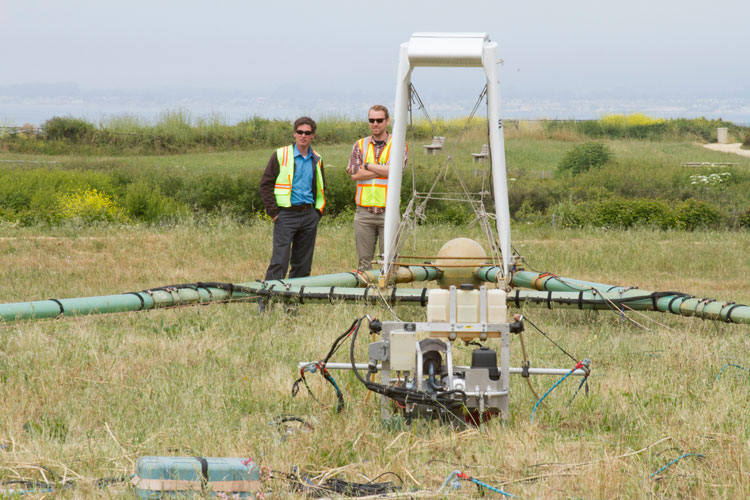Soquel Creek Water District Evaluating Actions to Protect Community Water Supply

This was an advanced, airborne technology called SkyTEM, gathering data to produce high-resolution mapping of the groundwater aquifers beneath the ocean floor. On shore these same groundwater aquifers contain Soquel Creek Water District’s (SCWD) drinking water supply.
The final report from that high-tech survey, commissioned by the Santa Cruz Mid-County Groundwater Agency (MGA) and released earlier this year, has confirmed the locations, extent, and imminent threat of seawater contamination of this crucial local groundwater supply.
SCWD provides water to over 40,000 residents in Aptos, Seascape, La Selva Beach, Soquel, and the City of Capitola. In addition to providing water to homes, the SCWD also supports many businesses with their 18,000 jobs, 22 parks, and 18 schools.
The State of California identified the Santa Cruz Mid-County Groundwater Basin as critically over-drafted because seawater contamination is occurring at the coast and poses a significant threat of contamination to the fresh drinking water that the community relies upon.
The MGA — which includes the SCWD, Central Water District, City of Santa Cruz, County of Santa Cruz and three private well representatives — are urgently concerned with seawater intrusion, which had already been detected in monitoring wells near Pleasure Point, Seascape, and La Selva Beach.
To understand the full scope of the problem, data was needed to identify the fresh water/saltwater interfaces in the groundwater basin offshore. To manage the basin’s precious groundwater effectively, the MGA needed information to know how close seawater intrusion is to the shore, what portions of the water supply aquifers are threatened by seawater contamination and where and the direction that intrusion is spreading.
“This information is essential in understanding both the immediate and future risks to the drinking water wells from seawater contamination,” said John Ricker, Water Resources Division Director at the County of Santa Cruz.
To get this data, the MGA (including the SCWD) commissioned a hydrological investigation into the condition of the groundwater basin, with Danish engineering and design firm Ramboll, who interpreted the survey data gathered by SkyTEM, a Danish geophysical survey company.
These groundwater assessment technologies where developed in Denmark, when seawater contamination and farming practices threatened groundwater supplies in that country.
The final report of that scientific investigation was presented to the MGA Board of Directors at their meeting on March 15, 2018. The results confirmed the locations, extent, and continuing threat of seawater contamination to our groundwater basin, and also point to additional critical problem areas.
“The science is in — seawater intrusion was verified to be significant at both the north and south ends of the District,” said Ron Duncan, General Manager of Soquel Creek Water District. “Even in areas where the District’s monitoring wells onshore didn’t detect seawater, the report shows that seawater intrusion is very close to shore — meaning without supplemental supplies it’s only a matter of time before that saltwater reaches those water wells.”
In the northern part of the study area, the report confirmed that the near-surface aquifer holds fresh groundwater, but the deeper sections contain brackish, seawater-contaminated water. According to the report, in the eastern area there is fresh water to a depth of about 165 feet, but below that depth is primarily salty water. And to the south, the water becomes increasingly brackish with increased salinity levels where saltwater has already contaminated the Aromas Red Sands aquifer in the La Selva Beach area.
“The quality of this technology has given us data which is conclusive,” says Duncan. He notes that the State of California recently signed an agreement with Denmark to gain access to their latest water technology and management techniques and apply it for statewide research, including much of the technology that the SCWD and MGA used for this survey.
The data is significant in how the SCWD and its MGA partners can address this critical groundwater contamination problem. Duncan says that detailed 3D geological representations of the subsurface, hydrological models, and scientific analysis of the data all point to an urgent need to develop additional supplies that will ensure the health and sustainability of the groundwater basin.
The SCWD and its MGA partners at the City and County of Santa Cruz are currently exploring supply and aquifer replenishment options for addressing the seawater intrusion threat to our Mid-County drinking water supply. Central Water District does not have coastal wells, but is also concerned about saltwater intrusion and seeks to educate the public in a way that creates an understanding of the need for action in a balanced approach.
The local community has done a great job of reducing water use during the last several years, and is urged by the MGA to continue its water conservation efforts. MGA water agency managers all agree that water conservation, along with moving water production wells further inland has reduced the imminent threat of seawater intrusion, but a longer-term response is needed to ensure groundwater sustainability into the future.
Toward that goal, as part of the SCWD’s Community Water Plan and the City’s Water Supply Advisory Commission Report is to explore the development of new water supplies including: stormwater capture, water transfers, use of desalinated water, and use of purified recycled water to replenish the groundwater basin.
•••
For more information visit: soquelcreekwater.org and midcountygroundwater.org